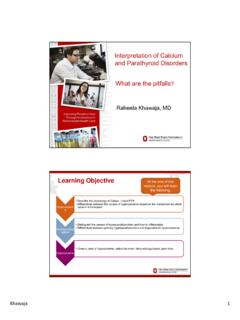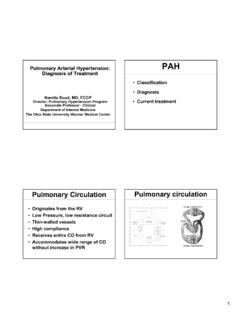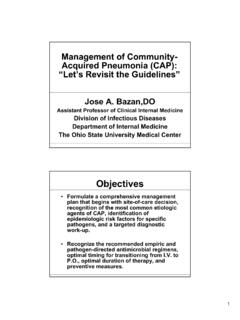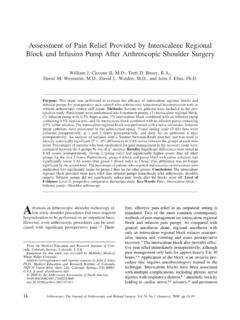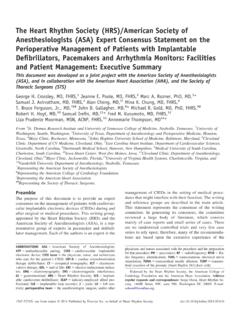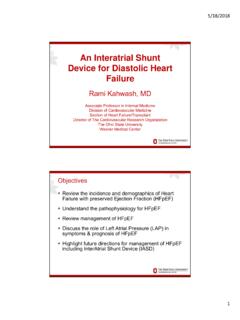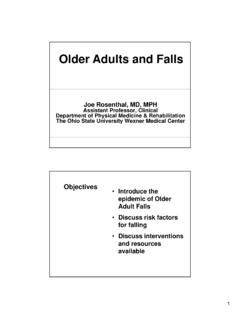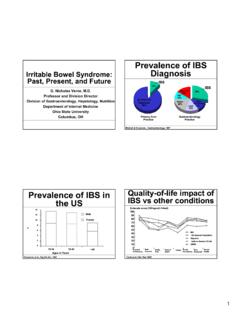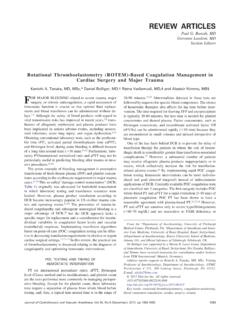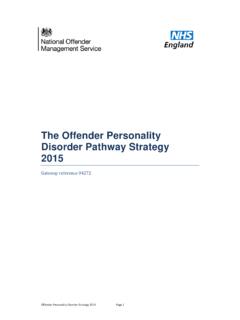Transcription of Assessment and Objectives Management of Bipolar Disorder
1 1 Samar McCutcheon, MDClinical Assistant ProfessorDepartment of PsychiatryThe Ohio State University Wexner Medical CenterAssessment and Management of Bipolar Disorder ObjectivesObjectives Establish criteria for Bipolar spectrum disorders Formulating an accurate diagnosis Review approaches to treatmentWhy talk about Bipolar Disorder ?Why talk about Bipolar Disorder ? 12thmost common disabling condition 10 year lag in diagnosis and treatment Potentialrisk of using unopposed antidepressants Loss of healthy life years Increased risk for premature deathDefinitionsDefinitions Episodicmood Disorder characterized by mania, hypomania and/or depression Subtypes: Bipolar I Disorder : mania +/- hypomania and depressive episodes Bipolar II Disorder .
2 Hypomania + depressive episode No manic episodes Other Specified Bipolar Disorder /Unspecified Bipolar Disorder2 DSM-5 Criteria: ManiaDSM-5 Criteria: ManiaA) Distinct period of abnormally and persistently elevated, expansive, or irritable mood and abnormally and persistently increased activity or energy, lasting at least 1 week and present most of the day, nearly every day (or any duration if hospitalization is necessary)B) During the period of mood disturbance and increased energy or activity, three (or more) of the following symptoms (four if the mood is only irritable)
3 Are present to a significant degree and represent a noticeable change from usual behavior:DSM-5 Criteria: ManiaDSM-5 Criteria: Mania1) Distractibility ( , attention too easily drawn to unimportant or irrelevant external stimuli), as reported or observed2) Excessive involvement in activities that have a high potential for painful consequences ( buying sprees, sexual indiscretions)- Impulsivity3) Inflated self-esteem or GrandiosityDSM-5 Criteria: ManiaDSM-5 Criteria: Mania4) Flight of ideas or subjective experience that thoughts are racing5) Increase in goal-directed Activity (either socially, at work or school, or sexually) or psychomotor agitation ( , purposeless non-goal-directed activity)6) Decreased need for Sleep ( feels rested after only three hours of sleep)7) More Talkative than usual or pressure to keep talkingDSM-5 Criteria: ManiaDSM-5 Criteria.
4 ManiaC) The mood disturbance is sufficiently severe to cause marked impairment in social or occupational functioning OR to necessitate hospitalizationto prevent harm to self or others OR there are psychotic featuresD) The episode is not attributable to the physiological effects of a substance or another medical conditionNew disclaimer allows for diagnosis for antidepressant induced mania if the symptoms persist beyond the physiological effect of that treatment 3 DSM-5 Criteria: HypomaniaDSM-5 Criteria: HypomaniaHow does it compare to mania?
5 Different in DURATION and INTENSITYTime criteria: 4 days instead of 1 week Unequivocal change in functioning but no marked impairment in functioning, no hospitalization and no psychotic featuresDSM-5 Criteria: DepressionDSM-5 Criteria: DepressionA) Five (or more) symptoms in a 2 week period with at least 1 of the symptoms being depressed mood or loss of interest/pleasure1. Depressed mood2. Sleep- Insomnia or hypersomnia 3. Diminished interest or pleasure in all or almost all activities4. Feelings of worthlessness or excessive or inappropriate guilt5.
6 Fatigue or loss of energyDSM-5 Criteria: DepressionDSM-5 Criteria: Depression6. Diminished ability to concentrate or indecisiveness7. Significant weight loss when not dieting or weight gain (5% change in body weight) or a decrease or increase in appetite nearly every day8. Psychomotor agitation or retardation observable by others9. Recurrent thoughts of death, recurrent suicidal ideation without a specific plan, or a suicide attempt or plan for committing suicideDSM-5 Criteria: DepressionDSM-5 Criteria.
7 DepressionB) Symptoms cause clinically significant distress or impairment in social, occupational or other important areas of functioningC) Symptoms are not attributable to the effects of a substance or to another medical condition4 DSM-5 Episode SpecifiersDSM-5 Episode SpecifiersSpecifiers describing the clinical status of the current/most recent episode -Mild, Moderate, Severe, In Partial Remission, In Full RemissionSpecifiers describing features of the current episode -With Anxious Distress -With Mixed Features -With Rapid Cycling -With Melancholic Features -With Atypical Features -With Mood-congruent Psychotic Features -With Mood-incongruent Psychotic Features -With Catatonia -With Peripartum Onset -With Seasonal PatternKey Clinical FeaturesKey Clinical Features Bipolar II Disorder can cause more long term impairment In both Bipolar I and II.
8 Depressive episodes are most common and often hardest to treat With psychotic features, delusions are more common than hallucinations Persecutory, sexual, religious, politicalAssessment of the PatientAssessment of the PatientClinical Case: John is a 23 year old male who is a newly established patient in the clinic and presents with report severe depression. On quick review of SIGECAPS, he is positive for all symptoms except suicidality. He has no previous mental health diagnoses on chart of the PatientAssessment of the Patient Depression Mania Hypomania Suicidal thoughts, behaviors or plan Risk factors for suicide attempts Psychotic features Co-morbiditiesRoutine history should assess for.
9 5 Assessment of the PatientAssessment of the Patient Obtain collateral from the family Don t forget, insight is often impaired during manic episodes Ask about family history (again) Assessment of the PatientAssessment of the Patient Consider secondary (medical) causes of mania Drug abuse: amphetamines, cocaine, MDMA, bath salts Medications: amantadine, L-Dopa, captopril, corticosteroids, baclofen, cimetidine, antidepressants Infectious: HIV, neurosyphilis Neurologic: complex partial seizures, MS, TBI, Huntington s, tumors, frontotemporal dementia Systemic conditions: B12 & niacin deficiencies, hyperthyroidism, Cushing s diseaseAssessment of the PatientAssessment of the Patient Should you use a Bipolar screening tool?
10 Mood Disorder Questionnaire Identifies ~ 67% of Bipolar patients False positive rate is ~ 20% Less likely to catch Bipolar II diagnosis (sensitivity of 39%) Strength is in specificity (approximately 90%) Zimmerman 2012 Assessment of the PatientAssessment of the PatientRule out conditions that can mimic Bipolar DisorderMajor Depressive DisorderADHDB orderline personality DisorderSchizoaffective DisorderSubstance Induced Mood Disorder6 Assessment of the PatientAssessment of the PatientHistory features suggestive of Bipolar Disorder rather than Major Depressive Disorder Early age at onset Early depressive episodes Multiple recurrences of depressive episodes Poor antidepressant response history
